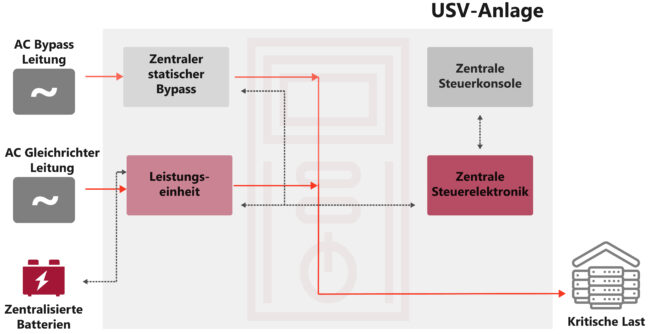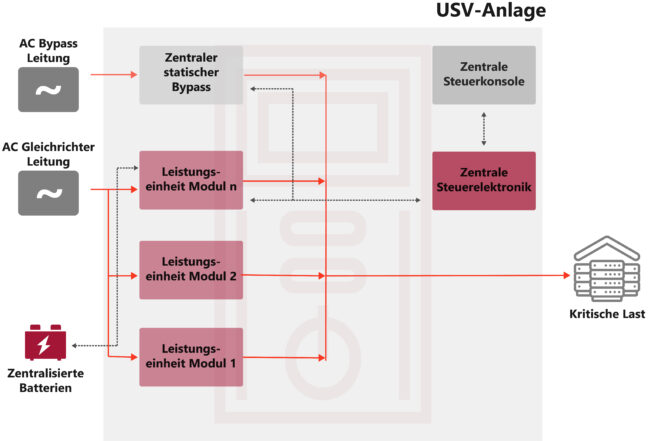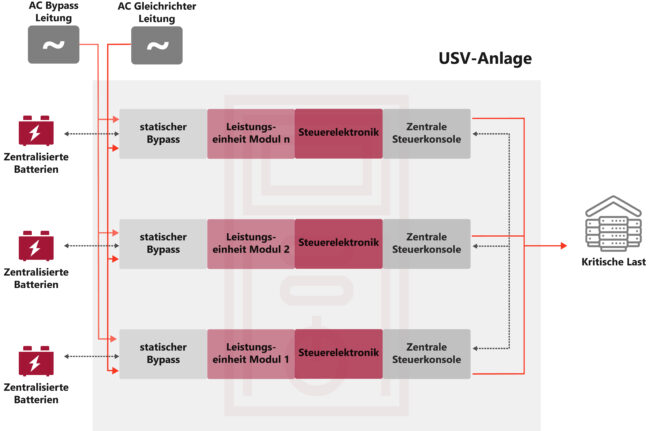UPS architectures and their impact on availability

An uninterruptible power supply (UPS) system is used when the main power source is interrupted or even fails to provide a continuous supply of electricity. To ensure maximum power quality and protect the load at all times, the UPS system should never have to be connected directly to the mains supply. This endangers the connected load.
There are now a large number of different systems on the market that differ in terms of their architecture. The developer of a UPS system must always have the goal of providing the end user with a reliable and uninterrupted power supply for as long as possible. Different architectures have different strengths and weaknesses. The various structures often differ in terms of availability. This must be maximized so that the UPS actually works when it is needed. Two important measures of availability are MTBF (Mean Time Between Failure) and MTTR (Mean Time to Repair). A high availability of the UPS system results from a low MTTR and a high MTBF.
This can be compared to the architecture of a ship. A ship should float on the water for as long as possible. If the architect does not work with precision, the time in which the ship glides over the water is reduced. If the ship sinks after a short time due to a faulty design, it does not fulfill its actual purpose.
In the same way, the UPS architecture must be designed with the aim of increasing the time in which it fulfills its function: To supply the load with power safely and without interruption for as long as possible.
Understanding the different UPS architectures is important as it has a direct impact on the availability of the systems. The five most important architectures are presented below:
1) Standalone architecture
The standalone architecture without transformer includes all the standard components of a UPS:
- Internal static bypass
- Maintenance bypass switch
- Inverter
- Rectifier
- Control logic
Each component is key to ensuring a continuous supply of clean electricity. However, it can be argued that in reality, every component in the system is a potential single point of failure that poses a risk to the system: If just one component fails, the entire system is already shut down.
Redundancy is the most common method of improving the availability of a UPS system. This can significantly increase the MTBF. A single standalone UPS has no redundancy. To create a redundant system, the standalone UPS must be replicated with a second unit. Adding a second unit has an impact on costs as the price of the system effectively doubles.
In configurations with a single standalone UPS, the entire system must be shut down in the event of a fault or necessary maintenance. The load would have to be switched to the direct power grid, which increases the risk of a complete failure of the load. The load is more vulnerable in the power grid. The MTTR is high in this case.
Autonomous UPS systems are therefore best suited for applications that do not require high availability of a device and where the risks associated with switching to the mains can be accepted.

2) Standalone with non-hot-swappable modules
In this case, a standalone UPS was developed and equipped with fixed modules. Each fixed module can contain components such as rectifiers and inverters, while many other components such as the static bypass and control logic are used together for the entire UPS system.
When configured correctly, this architecture has a certain degree of redundancy, which has a positive effect on availability. However, there are still several individual potential points of failure, which reduces the MTBF.
The modules cannot be replaced during operation. Therefore, if repair or maintenance is required, the UPS must be switched to a maintenance bypass or an internal static bypass. Switching to the bypass means that the load is connected to the mains and is not protected.
The repair is also time-consuming (high MTTR), which significantly reduces availability.
3) Modular centralized architecture
The modular centralized UPS is the next step up from a standalone system. The centralized architecture introduces redundancy through the use of modules.
These modules can be replaced during operation (hot-swap capability) - without the need to switch to a maintenance bypass. In the event of a power module failure, this increases availability through improved MTTR.
However, there are still individual potential points of failure with this architecture. Regardless of the redundancy, there is a centralized control logic that makes decisions for the entire system, a centralized bypass and a common communication channel. If one of these components fails, the load is no longer protected.

4) Modular decentralized structure
Here, each module contains all the elements of a UPS including rectifier, inverter, static bypass and control logic, which further improves availability. By eliminating some single points of failure, this architecture takes a step forward in terms of availability. This results in systems with high availability and a low downtime of 31.5 seconds per year on average.
The modules can be replaced during operation, but there is still a master module that makes decisions for the entire system via its control logic. The communication lines between the modules are not redundant, the static bypasses are decentralized but also not redundant. If a static bypass within a module fails, the entire system is switched to the static bypass, which can lead to a potential single point of failure where the load is exposed to the unprotected power grid.
Crucially, there is also no provision for potential human error when replacing modules. This means that a technician working under pressure to respond to a fault does not have the ability to isolate and test modules that are added to a live system.
The bypass fuses are also included in each module, which means that in the event of an output short circuit, the repair time (MTTR) is increased. These output short circuits represent a significant number of failures in UPS systems.
5) Modular distributed architecture
Here the architecture is fully distributed, with each UPS module comprising rectifier, inverter, static bypass and control logic. No single module makes decisions for the entire system, instead distributed decision making takes place to eliminate the single point of failure of the logic.
The static bypass is distributed and redundant, so if one part of the system fails, it is automatically isolated while the supply to the load is maintained by the other modules. The load is still protected. The communication lines have built-in redundancy so that if one line fails, communication continues via the UPS.
In this case, human error is also minimized for the first time by the safe-hot-swap capability. This means that a technician who needs to replace a module can simply open its parallel isolator and physically disconnect it from the load. The remaining modules continue to power the load on the inverter, while the technician can fully and safely test the module before reconnecting it to the load. There is no need to switch to manual bypass, even for firmware upgrades. With a pure hot-swap functionality this is not possible, and a fault in a new module or an error by the technician could cause the entire load to fail. As a result, this means that the distributed modular UPS architecture offers the highest possible level of availability and achieves downtimes of just 0.0315 seconds per year.

This distributed architecture is referred to as a "true modular system", which means that there are no single points of failure, that each component is redundant and that the margin for human error is reduced to a minimum.
The purpose of the UPS is to provide stable protection, clean voltage and a power source for emergencies. For critical power systems that require maximum availability, the UPS should never have to switch to the mains as this poses a risk to the load. A distributed modular UPS ensures that the power supply remains protected at all times and should be the UPS of choice for critical installations. It offers the highest possible availability - by minimizing MTTR and maximizing MTBF.
Wöhrle Stromversorgungssysteme GmbH offers such genuine modular, hot-swappable UPS systems with maximum availability (99.9999999 %). With the modular UPS systems of our Wöhrle Power series "WP" or the flexible solutions of the WISUS series, you can secure your load in the best possible way. In addition, our 360° service offer provides you with all-round protection for the entire service life of the systems. Contact us - we offer customized solutions for your application.